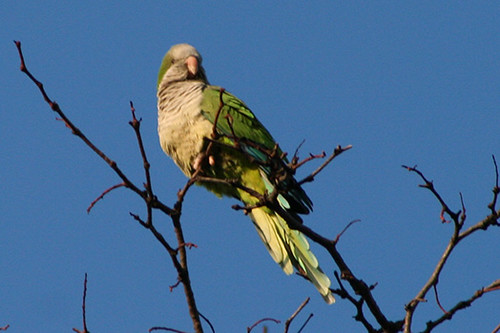 A monk parakeet in Washington Park, outside of a nest near Payne Drive. Image by Mark KuykendallChicago’s own parrot colony won’t let a polar vortex ground them.
A monk parakeet in Washington Park, outside of a nest near Payne Drive. Image by Mark KuykendallChicago’s own parrot colony won’t let a polar vortex ground them.
The city’s most unlikely feathered residents, bright green and talkative as ever, are alive and well after surviving some of the coldest temperatures ever recorded in the area.
Despite the arctic blasts, birdwatchers have spotted monk parakeets throughout the Chicago area, including five spotted in the west Chicago suburb of Elmhurst on Jan. 7, when temperatures dipped to 15 below zero. The birds have since been sighted on the University of Chicago campus, and are frequently seen near their large nests in Washington Park at the intersection of South Cottage Grove Avenue and East 54th Street.
“It wouldn’t have been easy for them, but they’ve been through weather like this before,” said Josh Engel, a researcher in the Bird Division at the Field Museum in Chicago.
Monk parakeets, a species of parrot native to subtropical regions of Argentina, Brazil and Uruguay, were first spotted in Chicago in the late 1960s and had established a colony in the Hyde Park neighborhood by the late 1970s. Theories about their origin suggest that a small flock escaped from a shipment at O’Hare Airport, or that the colony began as an accumulation of unwanted pets released by Chicago residents.
Whatever their origin, the birds have proved remarkably resilient, surviving temperatures as low as 17 below zero in the 1970s and 27 below zero in the 1980s. In fact, their population has multiplied.
Christopher Appelt, a biological sciences professor at St. Xavier University in Chicago whose research focuses on monk parakeets, was involved in a 2012 study that counted 249 active nests and approximately 778 of the birds residing in the Chicago area. But he contends the estimate “was really low end, there’s probably more. One thousand would be a conservative estimate.”
 Monk Parakeets look for food on a tree in Washington Park. Image by Mark KuykendallHe wasn't surprised that the monk parakeets stood up to the bitter cold. “I’ve never heard any reports of dead birds found after cold snaps,” Appelt said.
Monk Parakeets look for food on a tree in Washington Park. Image by Mark KuykendallHe wasn't surprised that the monk parakeets stood up to the bitter cold. “I’ve never heard any reports of dead birds found after cold snaps,” Appelt said.
Chicago’s recent weather was so cold that the city earned the nickname of “Chiberia,” alluding to the subarctic expanse of Russia where subzero temperatures are common and the sparse wildlife is specially equipped for the unforgiving climate.
So how does an exotic bird from South America manage to survive the frozen winters of Chiberia?
According to Stephen Pruett-Jones, a researcher and associate professor of ecology and evolution at the University of Chicago, the birds are uniquely suited to survive in the region.
“The monk parakeet is the only species of parrot that builds its own nest. If they did not build their own nest, they would not be able to survive in Chicago. They are almost preadapted to live in the area,” said Pruett-Jones.
Their unique nest building ability keeps them sheltered, and Chicago bird lovers do the rest. Studies involving both Pruett-Jones and Appelt have shown that the birds’ primary winter food supply comes from bird feeders put out by Chicago residents.
“If they have food and can get out of the wind, they can survive these temperatures,” Pruett-Jones said. Large monk parakeet nests in near the intersection of South Cottage Grove Avenue and East 54th Street. Experts say the unique nests helped the subtropical birds stand up to Chiberian temperatures. Image by Mark KuykendallBeloved by the late Chicago Mayor Harold Washington, a former Hyde Park resident, many of the talkative birds now make their home in the park bearing his name near the University of Chicago campus. Washington even protected the colony from U.S. Department of Agriculture efforts to remove them, allowing their numbers to expand.
Large monk parakeet nests in near the intersection of South Cottage Grove Avenue and East 54th Street. Experts say the unique nests helped the subtropical birds stand up to Chiberian temperatures. Image by Mark KuykendallBeloved by the late Chicago Mayor Harold Washington, a former Hyde Park resident, many of the talkative birds now make their home in the park bearing his name near the University of Chicago campus. Washington even protected the colony from U.S. Department of Agriculture efforts to remove them, allowing their numbers to expand.
“When they first appeared there was some skepticism that they would survive, but they did,” said Engel. “I think they’re doing OK.”
Nobody is counting these tough birds out now. Whatever the weather, it appears the parrots of Chiberia are here to stay, providing a welcome splash of color against the cold gray of winter.